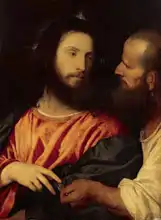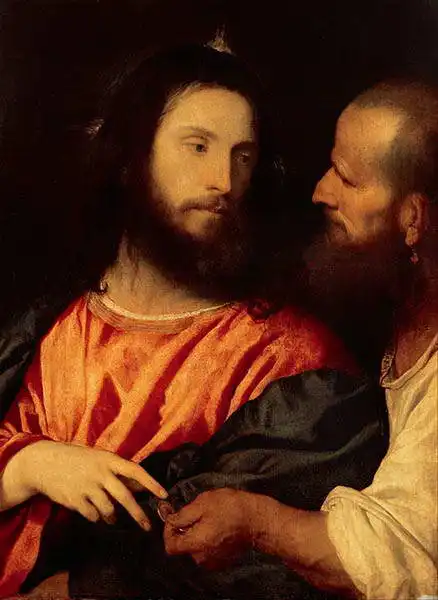The Tribute Money
Date:
1516Medium:
oil on boardLocation:
Gemaeldegalerie Alte Meister, Dresden, GermanyDimensions:
56 x 75"The Tribute Money" (or also known as "The Tribute Penny") is a painting by the Italian
Renaissance painter
Tiziano Vecelli , also known as Titian. This painting depicts a scene described in the New Testament where
Jesus and his disciples encounter the Pharisees who try to trap Jesus with a question about paying taxes to Caesar.
Titian depicted the biblical story from Matthew 17:24-27, where the Pharisees ask Jesus about paying taxes to the emperor. Jesus shows them the denarius and asks whose image is on it. When they tell him that it is the emperor's, he replies that then give to the emperor the things that are the emperor's and to God the things that are God's.
Titian stands out for his mastery in the use of color and light. The painting is full of vivid colors and dynamic light, which is typical of his Renaissance style. The figures in the painting are depicted realistically, with a strong emphasis on anatomy and clothing details. Titian often included
symbolic elements in his works. In this case, symbolism can be seen in the meaning of Jesus' answer regarding the tax and the separation of the worldly and spiritual realms. Titian created a balanced composition that emphasizes the interaction of the characters and the importance of the moment.
Tizian painted picture The Tribute Money in 1516. Prevailing color of this fine art print is brown and its shape is portrait. Original size is 56 x 75. This art piece is located in Gemaeldegalerie Alte Meister, Dresden, Germany. This image is printed on demand - you can choose material, size and finishing.
Full name
Tiziano Vecelli Da Cadore (1485-1576)He came from a family of lawyers and notaries. At nine years of age, he left to study in the contemporary centre of art: Venice. There, he met with not only
Leonardo da Vinci and
Albrecht Dürer. Tizian’s uncle promoted and developed his talent, until one day the young artist was admitted to the workshop of
Giovanni Bellini. His name worked its way into the minds of potential customers. When his master died, he became the main Venetian painter. His customers were Venetian Doges, for whom he not only painted portraits (
Jacopo Strada). Tizian’s paintings have become a symbol of luxury and wealth. After the coronation of Emperor Charles V, he was awarded a knighthood. In 1542, at the request of Pope Paul III, he moved to Rome, where he replaced
Michelangelo. Tizian laid the foundations for the
Renaissance and inspired artists, such as
Rembrandt and
Rubens.

